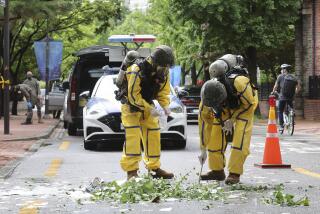Technology on the Rise : Tustin Firm’s Inflatable Antenna Passes a Key Test in Orbit
- Share via
WASHINGTON — About 25 years ago, L’Garde Inc., a small Tustin company, began pioneering a line of thin-skinned, multi-task balloons.
Tuesday, the research paid off. Members of Congress and NASA officials had a press conference to tout L’Garde’s tennis-court-size inflatable antenna: one of the largest and most complex inflatable objects that NASA has ever launched into space.
The space shuttle Endeavour carried the antenna packaged in a desk-size box, which it launched in a satellite this week. In a test Monday, its three 92-foot-long arms and 45-foot-wide dish was inflated with nitrogen gas, and by the next day, officials from NASA and L’Garde declared it a success.
The experiment effectively demonstrated that inflatable materials can be used to reduce costs and the weight of spacecraft and satellites, according to L’Garde and NASA officials.
“This technology has to go forward,” Costas Cassapakis, a physicist with L’Garde, said Tuesday. “Even if the experiment had failed, the technology would have paid for itself.”
Employing only 35, L’Garde started producing the inflatable products even before the federal government began calling for cheaper, lighter and better satellites.
The effort seems to be paying off.
While other government contractors have been suffering from budget cutbacks, L’Garde found a niche supplying objects that cost and weigh a fraction of what conventional technology could provide, and which are potentially more precise.
In 1971, the company introduced its first product, a decoy missile constructed for the Department of Defense. Since then, L’Garde has sent about 100 inflatable objects into space, all less than six feet long. But the antenna--$10 million and eight years in the making--is its biggest project.
It’s unclear what’s next for the privately held company, now averaging about $5 million in sales a year, virtually all in government contracts. L’Garde’s Cassapakis said future work partly hinged on whether the antenna experiment worked.
Alan Hirasuna, a L’Garde founder and vice president, expressed cautious optimism. “With this success and interest in the technology, we expect it to reflect itself in further development contracts,” he said. “But government contracts work slowly sometimes.”
Hirasuna pointed to the significant savings the inflatable antenna has already provided with this experiment, which cost between $10 million and $14 million. An antenna made from more conventional materials of similar size would cost $200 million to $400 million to launch into space, he said.
When the shuttle returns at the end of the week with data recorded on the experiment, L’Garde will go to work studying how to improve the antenna and begin work on its uses. If the funding continues, the antenna could be ready for practical application in three to five years, Cassapakis said.
The technology could be used to send equipment into space that’s capable of studying distant stars and planets. It also could be used for satellite communications on Earth, or to study the environment, including soil moisture and ocean salinity.
Rep. Christopher Cox (R-Newport Beach), who played host in Washington to L’Garde and NASA officials Tuesday, praised the company for its enterprise and called it “an unknown gem in Orange County.”
“The leap they made is equivalent to Galileo’s use of the first telescope [and] to Hubble’s account of stars being born,” Cox said.
NASA spokesman Murray Hirschbein said the space agency expects to continue working with L’Garde.
While he said NASA would know more about the future use of the technology once recorded data is analyzed, he said L’Garde removed all doubt that something like this can be done.
“Now we need to fill in the background,” Hirschbein said. “This step proved not only is the technology feasible, but it’s practical.”
(BEGIN TEXT OF INFOBOX / INFOGRAPHIC)
Space Inflation
An inflatable antenna designed by Tustin-based L’Garde Inc. passed its first test Tuesday by inflating properly in space. The $14-million experiment may pave the way for the use of inflatable structures in space instead of expensive mechanical ones. How it works:
1. A satellite carrying the antenna experiment is released into orbit 177 miles above Earth.
2. A timer triggers inflation, filling the antenna with nitrogen; the antenna remains attached to the satellite.
3. Video cameras record the inflation and transmit data to satellite; after about 90 minutes, the antenna detaches.
4. A space shuttle retrieves the satellite; the antenna remains in space and eventually disintegrates.
Space shuttle
Robotic arm
Satellite
Antenna
Struts
Antenna Details
* Dish-shaped and made of Mylar thinner than that used in birthday balloons
* The top portion has a silver reflective surface; the underside is clear
* Diameter: 45 feet
* Struts are 92 feet long, made of neoprene-coated Kevlar
Source: Jet Propulsion Laboratory, Pasadena; L’Garde; Researched by JANICE L. JONES / Los Angeles Times
More to Read
Inside the business of entertainment
The Wide Shot brings you news, analysis and insights on everything from streaming wars to production — and what it all means for the future.
You may occasionally receive promotional content from the Los Angeles Times.









